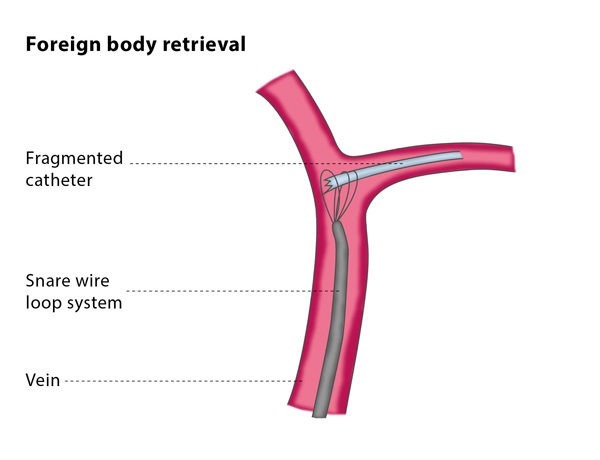The technique used in the procedure depends on whether the procedure aims to remove or reposition the foreign body, as well as on the type and location of the item.
There are a number of systems and grasping devices which may be used for the procedure. The most common tool for endovascular removal is a snare device which consists of a snare wire loop, a snare catheter, a device used to insert a catheter and a device which helps move wires around during difficult procedures. The device is positioned in a blood vessel to capture the foreign body, which is then retrieved inside the introducer and out of the body.
Percutaneous foreign body retrieval is usually performed as an in-patient procedure, so you will stay in hospital overnight. The site of the puncture and your vital signs will be monitored for the first 4-6 hours following the procedure.
Why perform it?
There are a number of reasons why you may be advised to undergo percutaneous foreign body retrieval.
There are a number of risks associated with foreign bodies, including septic complications due to bacteria on the foreign body, as well as the risk of dislocated stents and coils which may cause blood clots and restrict blood flow in the vein. Inferior vena cava filters and fragmented guidewires may pierce the wall of the vein, and cement fragments on soft tissues can be painful.
Possible vascular foreign bodies (in your veins) include a fragmented or badly positioned central venous catheter or an inferior vena cava filter, an arterial catheter or guidewire, or a displaced arterial stent or embolic materials (such as a coil or plug).
Possible non-vascular foreign bodies include displaced ureteral and biliary stents and catheters as well as cement fragments on the soft tissue.
The procedure may not be suitable for you if you have a blood-clotting disorder.
The rate of successful foreign body retrieval is very high – over 90-95% of endovascular retrieval attempts are successful. If the foreign body cannot be retrieved using a minimally invasive technique or your doctor thinks that an endovascular retrieval of the foreign body would be too difficult or too risky, your doctor may suggest the possibility of using the traditional surgical approach.
What are the risks?
The risks associated with the procedure are fairly rare and usually do not require treatment. The most common complications are bruising at the groin, heart arrhythmia and flail tricuspid valve (a valve in the heart which has lost its normal support and flutters in the blood stream).
Bibliography
1. Sheth R, Someshwar V, Warawdekar G. Percutaneous retrieval of misplaced intravascular foreign objects with the Dormia basket: an effective solution. Cardiovasc Intervent Radiol 2007; 30:48-53.
2. Lawrence PF. Retrieval of iatrogenic intravascular foreign bodies. J Vasc Surg 2013; 57:276-81.
3. Mitchell WB, Bonn J. Percutaneous retrieval of a Greenfield filter after migration to the left pulmonary artery. J Vasc Interv Radiol 2005; 16(7):1013-7.
4. Fisher RG, Ferreyro R. Evaluation of current techniques for nonsurgical removal of intravascular iatrogenic foreign bodies. AJR Am J Roentgenol 1978; 130(3):541-8.

